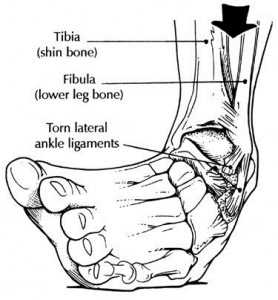Healthy Life: Ankle Pain – Causes and Symptoms (605)
Healthy Life: Sprained Ankle
蘇鎮邦 (Christopher So):
舒整物理治療師 (Manipulative Physiotherapist) 人類工程師 (Ergonomist)
The lower ends of tibia and fibula form the inferior tibiofibula joint. The tibia, fibula and talus form the talocrural joint or the ankle joint.
Ankle sprain is one of the commonest sports injuries because most sports involve running. The structure of the ankle makes inversion injury (ligamentous injury on the outside of the ankle) much more often than eversion injury (inside of the ankle). During running, the ankle is in plantaflexion position meaning the foot (ankle) is on tip toe. In this position, the side way movements are greatly enhanced. The inversion range of movement is greater than eversion roughly 3:1. Thus, inversion injuries comprise more than 80% of all ankle injuries. Activities such as running and dancing (especially with high heel shoes) which involve plantaflexion will greatly increase the chance of sprained ankle. Also, walking on uneven surfaces such as grass and gravels increases the chance of a sprained ankle. On the other hand, during squatting the ankle is in a close packed position with full dorsiflexion and eversion (see diagram). It is impossible to sprain the ankle.
Ankle sprain will cause immediate swelling or delayed swelling a few hours after the injury or even the following morning. Ankle sprain ranges from minor strain with micro tearing of the ligaments, to a sprain with partial tearing of the ligaments, to rupture or full tearing of the ligaments which will result in instability. Also, the tearing of the ligaments will involve the nerves within these ligaments which are essential for feedback to the brain for our balance function.
However, the treatment of all ankle sprain injuries is fairly similar. At the acute stage, use the RICE regime which involves rest, ice, compression and elevation (if swelling is significant). If it is the first time, even with minor ankle sprain it is important to get help. If it is not treated properly, it is likely to cause a vicious cycle of recurrent ankle sprain conditions. Therefore, pain relief and reduced swelling are the initial treatments. Restoration of the full range and strength of the ankle movement, plus balance ability, are the ultimate goals for treatment of ankle sprain.
Pain relief and reduced swelling can be achieved by applying ice, ultrasound and interferential therapy. Ultrasound therapy has two effects. Firstly, it increases circulation and promotes healing. Secondly, it increases the permeability or the ability to pass particles from one cell membrane to the other. Thus, it promotes the recovery process. Manual therapy can correct the mechanic faults, breaking down the scars and restoring the functions. Exercise is the key to full recovery that even the physiotherapist cannot achieve without the patient’s active co-operation.

Diagram 1 Structure of the Ankle Joint

Diagram 2 Muscles and ligaments

Diagram 3 Inversion injury
